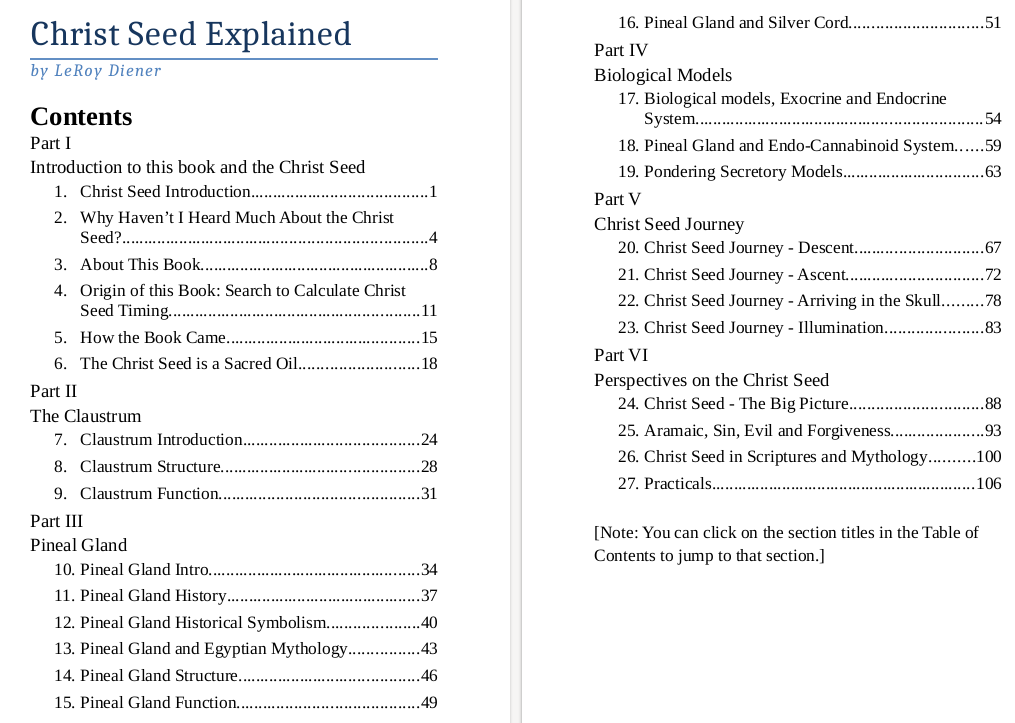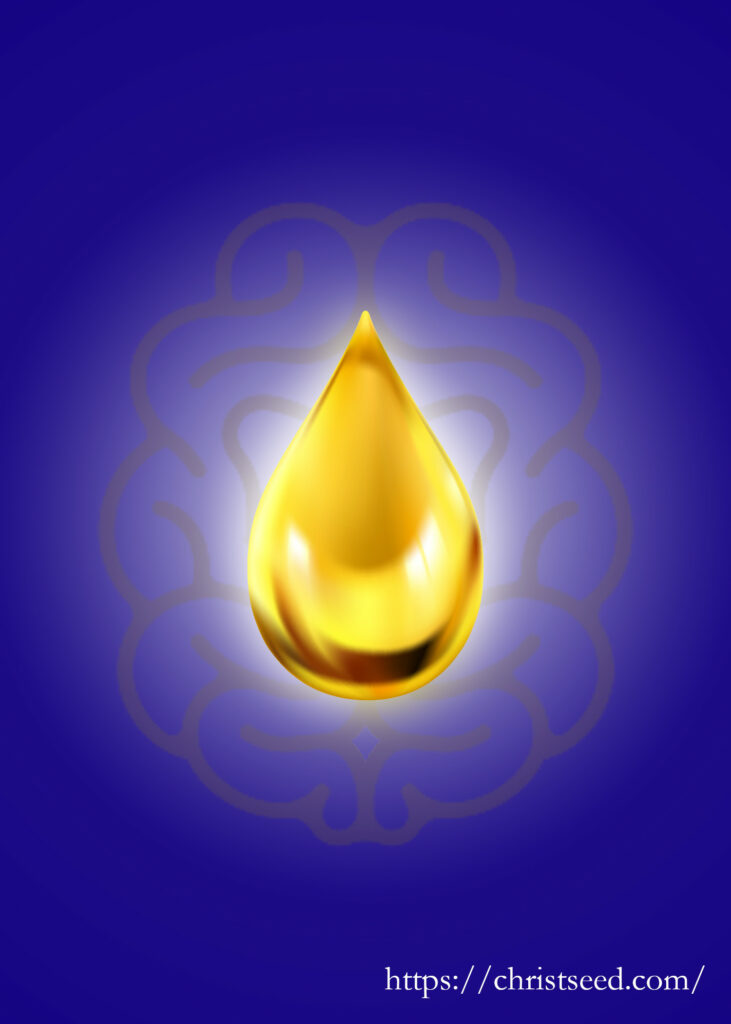Christ Seed Book Available Now Christ Seed Explained
Christ Seed Book Christ Seed Explained
Christ Seed Book Available – Christ Seed Explained
- 1 Christ Seed Book details
- 2 Christ Seed Book ordering info
- 3 Christ Seed Book: what’s inside?
- 3.1 Table of Contents
- 3.2 Introduction to this book and the Christ Seed
- 3.2.1 Christ Seed Introduction
- 3.2.2 Christ Seed Oil – Chrism
- 3.3 Claustrum
- 3.3.1 Claustrum Structure
- 3.3.2 Claustrum Function
- 3.4 Pineal Gland
- 3.4.1 Pineal Gland Intro

Christ Seed Book details
Book Sub-title: How to regenerate Mind, Body and Spirit through the Christ Seed oil in your own Brain
As of January 2021, Christ Seed Explained e-book is available.
Christ Seed Explained is available only in e-book format.
Information about how to order is below. At this time, you’ll need to contact me personally. Soon, I might have an automated order system, but not yet.
This is the first edition of the book.
Note: Detailed information about how to preserve the Christ Seed is in the Christ Seed Monthly Advisory (CSMA), not in the book. The book provides comprehensive background info which is important as context. In my opinion, the most appropriate place for detailed instructions is in the CSMA, as the instructions are relevant to the timing of the Christ Seed, which varies from one individual to another.
About 120 pages.
Pricing
- The Christ Seed Explained e-book cost is $50.
- The Christ Seed Monthy Advisory cost is $100 for a CSMA for one year for one person. A summary of the Christ Seed Explained e-book is embedded in your annual Christ Seed Monthy Advisory.
- Christ Seed Consultation cost by phone or jitsi or zoom or skype is $100 per hour.
Christ Seed Book ordering info
How to Order
To order, send me an email or text or phone.

Your contribution is essential to the continuation of this work. You are greatly appreciated.
Please, do not hesitate to contact me with any questions.
Christ Seed Book: what’s inside?
Table of Contents
Here’s a sneak peak.

Ready to buy the book? Christ Seed Book ordering info
Introduction to this book and the Christ Seed
Christ Seed Introduction
Christ Seed Introduction
The Christ Seed is a psycho-physical germ. It is not clear what the origin is of the name “Christ Seed.” It does not have a close connection with Christianity in its modern form, nor is it related to seeds. The Christ Seed is a physical substance that is produced monthly in the human body following lunar cycles. It has the potential to seed or to germinate spiritual progress and to increase one’s well-being in body, mind and spirit. If the Christ Seed is not destroyed during its three-day maturation and journey through the body, then it gets stored. Over the years, it can accumulate and increase one’s propensity towards enlightenment.
The Christ Seed is an oil that is produced monthly in the human body following the moon cycles. The Christ Seed matures in three days, journeying between the pineal gland, the pituitary gland, the mid-brain, the medulla oblongata, the Ida, the pingala, the solar plexus, the sacral plexus, the spinal column, the vagus nerve, etc.
The Christ Seed is called different names by some people. There’s a long list of other names for the Christ Seed later in this book. A few of the more common names are Christ Seed oil, chrism, chrism oil or Christ Seed chrism oil.
My objective here is to help people to bring this ancient knowledge into their lives and to integrate their awareness in a way which produces tangible change in their quality of life.
Ready to buy the book? Christ Seed Book ordering info
Christ Seed Oil – Chrism
Christ Seed is a Sacred Oil
Christ Seed Oil – Chrism
The Christ Seed is a sacred oil. This oil was named Christos by the Greeks. According to the Wikipedia entry for Christ, “The word Christ (or similar spellings) … is derived from the Greek word Χριστός, Christós (transcribed in Latin as Christus)… Christós in classical Greek usage could mean covered in oil, or anointed, and is thus a literal translation of messiah.” According to the Wikipedia entry for Messiah, “A messiah (literally, “anointed one”)[1] is a saviour or liberator of a group of people.” This Wikipedia entry references the online etymology dictionary, which says
messiah (n.)
c. 1300, Messias, from Late Latin Messias, from Greek Messias, from Aramaic meshiha and Hebrew mashiah “the anointed” (of the Lord), from mashah “anoint.” This is the word rendered in Septuagint as Greek Khristos (see Christ). In Old Testament prophetic writing, it was used of an expected deliverer of the Jewish nation. The modern English form represents an attempt to make the word look more Hebrew, and dates from the Geneva Bible (1560). Transferred sense of “an expected liberator or savior of a captive people” is attested from 1660s.
Christ (n.)
title given to Jesus of Nazareth, Old English crist (by 830, perhaps 675), from Latin Christus, from Greek khristos “the anointed” (translation of Hebrew mashiah; see messiah), noun use of verbal adjective of khriein “to rub, anoint” (see chrism). The Latin term drove out Old English Hæland “healer, savior,” as the preferred descriptive term for Jesus.
A title, treated as a proper name in Old English, but not regularly capitalized until 17c. Pronunciation with long -i- is result of Irish missionary work in England, 7c.-8c. The ch- form, regular since c. 1500 in English, was rare before. Capitalization of the word begins 14c. but is not fixed until 17c. The 17c. mystical sect of the Familists edged it toward a verb with Christed “made one with Christ.”

The Christ Seed oil is also known as chrism.
Ready to buy the book? Christ Seed Book ordering info
Claustrum
Claustrum Structure
Claustrum Structure
The claustrum is a mysterious brain structure. The word claustrum means “hidden away.” Indeed, the claustrum is a thin, irregular sheet of grey matter, one sheet in each hemisphere of the brain, concealed beneath the inner surface of the neocortex. Viewed face on, it has an irregular outline remarkably reminiscent of the 48 contiguous United States. The thickness varies from a fraction of a millimeter to several millimeters. The claustrum is not flat but curved in a curious way.
In contrast with most brain structures, the anatomy of the claustrum is quite remarkable in that it receives input from almost all regions of cortex and projects back to almost all regions of cortex. The other brain parts that come close to this interconnectivity are the cortical pyramidal neurons, whose axons carry the bulk of long-distance cortical communications. This is in contrast to the claustrum, which is small and centrally located.
Unlike the outstretching axons of the pyramidal neurons, the claustrum is positioned at the confluence of a large number of simple cortical loops. This widespread and reciprocal connectivity with most cortical regions raises the obvious question: why is all this information brought together, since this requires most of the loops being much longer than if the claustrum lay more uniformly under the cortex?
Ready to buy the book? Christ Seed Book ordering info
Claustrum Function
Claustrum Function
The claustrum’s function is obscure. Our existing knowledge is insufficient for understanding how the claustrum functions. Neuroscientists speculate that the claustrum may play the primary role in consciousness. So far, scholars who speculate on the neuronal basis of consciousness attribute to the cortical pyramidal neurons the role of synthesizing neural stimuli into consciousness. A key feature of almost all neuronal theories of consciousness is the imperative for interactions among groups of widely dispersed pyramidal neurons that continuously express themselves in the ongoing stream of conscious percepts, images and thoughts.
Objects or events in the real world have many simultaneous attributes: color, shape, distance, velocity, smell, sound, feel, etc. If both claustra are absent, these attributes may not be experienced in an integrated manner, so the person may fail to perceive some objects or events or only be consciously aware of some isolated attribute. This suggests that the claustrum may play a role in synthesizing neural stimuli into consciousness.
The clausturm appears to have a relatively uniform architecture. A striking feature of the claustrum is the few neuronal types that it has when compared with those of the cerebral cortex. What then is the nature of the work performed by claustral neurons? The homogenous cell structure and architecture of the claustrum conveys a predisposition that the claustral neurons could be especially sensitive to the timing of the inputs, cementing the role of the claustrum in binding disparate events into a single percept, experienced at one point in time. This dynamic is critical for the synthesis of neural stimuli into consciousness.
A striking feature of the claustrum is the few types of neurons it has compared with those of the cerebral cortex.
Ready to buy the book? Christ Seed Book ordering info
Pineal Gland
Pineal Gland Intro
Pineal Gland Intro
The sacred oil secreted from the claustrum is differentiated into electric and magnetic portions by the pineal gland and pituitary glands, respectively. The pineal gland is considered to be masculine. The pineal body is our masculine spiritual organ. The pineal gland is associated with solar and yang energy. The pituitary gland is considered to be feminine. The pituitary body is our feminine spiritual organ. The pituitary gland is associated with lunar and yin energy.
The pineal gland and the pituitary gland are also known as Joseph and Mary, respectively, the ones who are responsible for sending the Christ Seed on its journey, also the ones who await the return of their son who is given birth in the solar plexus. It is said that the pineal gland secretes honey and that the pituitary gland secretes milk. This parallels the biochemical understanding that the pineal gland secretes DMT and that the pituitary gland secretes serotonin. Incidentally, the word secret is derived from the word secretion. The electric portion differential by the pineal gland is also referred to as Joseph, the father of the holy child. The magnetic portion differentiated by the pituitary gland is also referred to as Mary, the mother of the holy child.
The pineal gland shape resembles a pine cone. This name of the pineal gland is derived from Latin pinea, meaning “pine cone.” In phylogenetics, pine trees are in the Genus “Pinus,” one of the most ancient genera of terrestrial plants on Earth.
Ready to buy the book? Christ Seed Book ordering info
